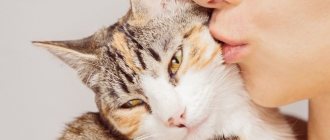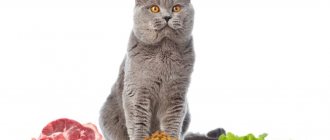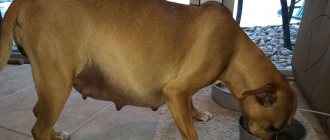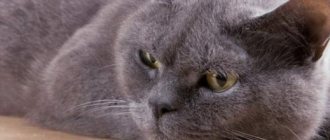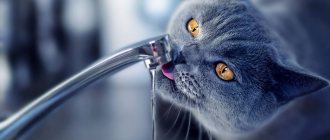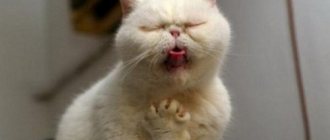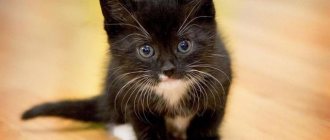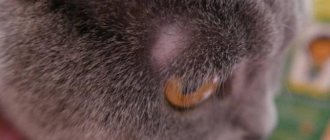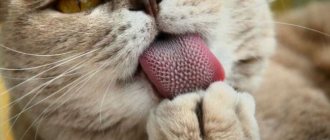Consumption rate
There are no general water consumption standards for cats. Their need for fluid depends on many factors - weight, age, individual characteristics and general health. You can calculate the approximate rate of water consumption for a cat: about 30 ml of water is required per kilogram of weight. Based on these data, it turns out that a cat that weighs 7 kg should drink 200 ml of water per day, that is, 1 glass.
- Thirst torments...
Attention! With age, a cat's need for water increases due to the natural decrease in the amount of fluid in the body. That's why older pets drink more than young ones.
Preventive measures
Your cat's water bowl should be fresh every day. It is not recommended to give your pet distilled or tap water, preferably filtered or boiled. The container with the liquid should be visible. The owner needs to ensure that the cat, suffering from thirst caused by disease, always has access to water. The body becomes dehydrated quickly, and a pet, deprived of the opportunity to quench its thirst, may die, especially an old one. For the same reason, if a cat has diarrhea, vomiting, but does not drink much fluid, you need to persistently offer your pet water.
Natural Causes of Thirst
Polydipsia is the medical term for increased thirst in cats. It can be caused by natural causes or pathological changes in the animal's body. Natural reasons why a cat drinks a lot of water are as follows:
- in high physical activity, which is especially typical for kittens who spend a lot of energy and try to replenish it with food and water;
- in high indoor temperatures, for example, in summer or winter with a heated stove (hot radiators);
- in the high body temperature of the animal associated with the disease;
- in foods high in salt;
- in pregnancy, lactation;
- lack of protein in the body;
- in taking certain medications, in particular diuretics.
Your cat may become thirsty if you switch her to a different food. For example, she used to eat wet or natural food, and then you suddenly switched to dry food. They contain a very small percentage of liquid and the animal naturally replenishes its deficiency by drinking additional fluids.
If your pet lives with you for a long time, then you should know the approximate amount of water it consumes. Has the amount of liquid you drink started to increase? If the volume of water consumed has increased by 1.5 times per day, you need to contact a veterinarian.
At the vet
Attention! A cat may be constantly thirsty when stressed or very excited. This is not due to internal pathologies, but to psychogenic factors. In this case, it is advisable to limit her access to the drinking bowl.
Diarrhea in Cats and Kittens
If it is difficult not to notice such a deviation as constipation in your pet, then you will definitely not ignore diarrhea! “Healthy” stool should be well-formed, without mucus, blood and undigested food, and “issued” 1-2 times a day.
Diarrhea (diarrhea) is frequent (up to ten times a day) bowel movements of a cat. In this case, fecal masses can be different: pasty, liquid, watery, with a pungent odor, with mucus, with an admixture of blood. The color range is also very diverse.
Causes of diarrhea in cats and kittens:
- overeating, improper feeding, poisoning with toxic or poor-quality foods, medications, ingestion of small foreign objects into the intestines - that is, everything about which you can say “the cat ate something”
—food intolerance (allergy)
—psycho-emotional background
—avitaminosis
—parasites (worms, protozoa - cocci, lamblia, etc.)
—intestinal diseases (colitis, etc.)
—infectious diseases(!)
First aid for diarrhea
It is important to find out the cause of this unpleasant phenomenon, because although diarrhea in itself is not a disease, it can be a sign of a serious illness in a cat.
If your pet has diarrhea for the first time and is not accompanied by other symptoms - large loss of fluid, fever, lethargy and refusal to eat, then you can self-medicate.
In most cases, for short-term diarrhea, a 12-hour (for a kitten) - 24-hour (for an adult cat) fasting diet is sufficient.
Then you can give only easily digestible foods with low fat content, for example, white boiled chicken meat and broth, boiled rice. When feeding prepared foods - food for cats with sensitive digestion or a veterinary diet.
Feed should be frequent, but in small portions. After the cat has fully recovered, we return to the normal diet.
To stop diarrhea the following are used: activated carbon (¼ -1/2 tablet dissolved in a small amount of water, 2 times a day), rice broth, oak bark decoction (5 ml 2-3 times a day), Smecta (dissolve the bag in ½ glass of warm water, 5 ml 3 times a day), Enterosgel (1 cm of gel per 5 ml of water 2-3 times a day). It is more convenient to administer the products to the cat through a syringe without a needle.
Good veterinary medications for diarrhea include those containing probiotics and prebiotics. This is Vetom1.1. (this drug should be in the medicine cabinet of any cat owner), Pro-Kolin, lactobifid, lactoferon, etc. From homeopathy - veracol.
Of course, all of the above drugs should not be used at the same time.
But if the diarrhea has not stopped within 2 days, the pet’s condition has worsened, or new alarming symptoms have been added – we go to the hospital!
When to urgently contact a veterinarian:
— diarrhea becomes uncontrollable
— in the stool - blood (from scarlet to black)
— the animal has general lethargy, refusal to feed, apathy
— vomiting
When you need to rush to the veterinarian at full speed:
In small kittens, prolonged diarrhea without treatment is very dangerous! Diarrhea due to infectious diseases can quickly lead to dehydration and death of young animals.
Pathologies
Many serious diseases provoke severe thirst in felines. In this case, polydipsia manifests itself due to high water consumption in the body, which is caused by the disease. The cat drinks a lot of water when there is excessive sweating, which indicates the presence of illness, or when there is discharge from the genitals associated with inflammation. Constant thirst can also be caused by the following diseases:
- diabetes;
- renal failure in acute or chronic form;
- pyelonephritis;
- liver tumor;
- excessive functionality of the thyroid gland – hyperthyroidism.
The symptom of a cat drinking a lot of water and not eating much can include vomiting and diarrhea, blood loss or dropsy. Additional symptoms are lethargy, apathy, and rapid weight loss. Pain syndrome may also occur.
Attention! If your cat starts drinking a lot, don't limit it! A lack of fluid in the body provokes dehydration!
How much should a kitten and an adult cat normally drink?
The rate of water consumption is individual and depends on many factors:
- Animal body weight. For every kilogram of a cat's weight per day, ideally there should be from 20 to 40 ml of liquid. According to other sources, this figure should be about 50 ml.
- Age. Kittens drink less liquid than adults. Older cats, on the contrary, are characterized by increased thirst.
- Nutrition. If an animal is fed a premium ready-made food that contains no salt and has a balanced composition, it will require less water than its counterpart fed a cheaper product. Broths and gravies included in a pet's diet, which consists of natural food, provide their body with moisture, as a result of which their need for clean water is reduced.
- Level of physical activity. More active animals have greater thirst than their less active counterparts.
- Time of year and air temperature in the room where the cat is constantly located. In the heat, the cat's need for water increases.
The daily fluid intake of felines should be twice the weight of the food they eat. Knowing your pet's body weight, it is easy to calculate how much water he needs per day. To do this, you need to multiply its weight by 0.03. The resulting number will be the norm of fluid required by the cat’s body.
This is interesting: Red cat with green eyes
What does each discharge indicate when vomiting occurs?
Of course, an animal can vomit not only bile, but also other types of secretions. In order not to cause unnecessary panic, you need to understand the specific cause of this type of vomiting.
We suggest you familiarize yourself with: Shells of marine mollusks, how to remove a mollusk from the shell
Before the onset of this symptom, the pet will experience rapid breathing, and involuntary reflexes may appear, namely swallowing. There is also strong salivation.
Before the onset of vomiting, the pet notices rapid breathing
If spasms begin after eating, this may indicate that your pet has eaten too much grass or swallowed a large hairball. This caused irritation in the stomach.
For example, if a cat has vomited 1 or maximum 2 times and feels quite normal, then there is no particular reason to worry. You just need to monitor your pet’s condition for 24 hours, and if everything is fine, then you don’t have to see a doctor.
It is important to understand that inflammation of the uterus or intestines, as well as feline distemper, are also accompanied by such discharge. Therefore, if these symptoms are systematic, you should not postpone a visit to the doctor.
White foam is considered the safest; if an animal burps such a mass, then there is no need to worry too much. Of course, if this is a one-time spasm.
The most common cause of bile secretion is considered to be problems with the liver or kidneys.
If we are talking about bile or blood, then you should be especially careful. The most common cause of bile secretion is considered to be problems with the liver or kidneys. The same reason may be for green discharge. Moreover, in the latter case, in addition to liver disease, stomach problems cannot be ruled out.
When there is blood in the discharge, there may be other reasons. For example, scarlet blood indicates any damage to the pharynx or esophagus. The first thing you need to do is examine your pet's throat; most likely, wounds will be found there. Dark blood indicates damage to the stomach itself; here you cannot do without the help of a doctor.
If you are vomiting, you need to examine your pet's throat.
Diseases
Illness is another reason for indefatigable fluid consumption. It is quite easy to guess why the cat drinks a lot of water in this case. It's about problems that provoke thirst. Polydipsia does not appear due to the disease itself. The reason for thirst is the increase in water consumption by the body caused by the disease. There are a number of diseases that provoke an increased need for drinking in cats. These include:
- hepatitis;
- insulinoma;
- pyelonephritis;
- liver tumor;
- diabetes.
In addition, cats with acute or chronic renal failure drink a lot of water.
Help for the animal and medications
There is no reason to panic if the cat's thirst is caused by natural reasons. After weaning the offspring, the female will stop drinking a lot within a few days. When feeding dry food, you must ensure that the bowl of water is always full and alternate dry formulas with wet canned food.
A bowl of water is required
Feed should not be over-salted. If medications are the cause of thirst, it is worth discussing it with your veterinarian. He will adjust your medication intake.
If a cat drinks a lot and this is accompanied by vomiting, prolonged diarrhea, lethargy, and apathy, then it is necessary to take the animal to a veterinary clinic. The specialist will do blood and urine tests, check hormonal levels and conduct an ultrasound if diabetes is suspected. Drug therapy is prescribed by a veterinarian after an examination.
Please note that an animal may experience severe thirst during burns, even chemical ones, when fluid evaporates from the body and the body experiences a lack of moisture. Often, cats drink a lot of water when in heat due to blood loss. This indicates health problems.
What should the owner do?
The best thing is to call a veterinarian at the RosVet VC to your home and voice the problem. If the cat’s condition is stable, you can bring it to the clinic for examination by making an appointment by phone: +7.
Prepare an anamnesis (history), share observations about why it became noticeable that the cat drinks a lot, what other symptoms accompanied the increase in thirst. All this will facilitate the diagnosis of possible internal pathologies and allow the specialist to quickly prescribe treatment (if necessary).
When the alarm turns out to be false and excessive water consumption was caused by heat, physical activity or stress, the cat can be taken home with the advice of a veterinarian.
If you are concerned about your cat’s condition, don’t hesitate! The RosVet clinic receives visitors 24 hours a day. For any questions, you can contact us in advance by phone: +7 (495) 256-11-11, 24 hours a day.
Diagnostics
One of the first diagnostic methods is to take a blood test, which determines the presence of inflammation, anemia and altered red blood cells. It is also necessary to take a biochemical analysis to determine liver enzymes (ALT, AST and alkaline phosphatase). The level of direct and total bilirubin is also assessed.
Normal indicators in cats: ALT – from 19 to 78 units/l, AST – from 9 to 30 units/l, Bilirubin – from 2 to 16 µmol/l
A urine test also evaluates the presence of bilirubin and urobilinogen.
What affects water consumption
The daily water requirement for a cat is individual. With age, due to a slowdown in metabolic processes, it gradually decreases. A larger deviation is typical for pregnant pets - when carrying kittens, part of what they drink is transformed into the amniotic sac and milk.
In addition to age and physiological condition, it is necessary to take into account several more important factors: the type of feeding, the mobility and size of the animal, as well as the climatic conditions in the place of residence.
Nutrition
When feeding natural food, up to 75% of the liquid comes from food. The cat gets moisture from fermented milk products, vegetables, herbs, cereals, meat and fish.
With dry granules, the animal receives only 10% liquid. To maintain water balance and comfortable digestion of food, you need to drink a portion that is 2 times the volume of what you eat. Otherwise, an increased concentration of proteins and minerals may result in the formation of stones (kidney or bladder stones).
Body type and activity
The greater the mass of a mustachioed pet, the less its norm per kilogram. Calculation formulas for a miniature cat weighing only 2 kg and a large cat whose weight exceeds 10 kg will be different. In absolute terms, an animal with a powerful physique will have to drink more, but in relative terms, the need will be higher for those who are smaller.
In addition to size, daily activity is also important. Cats that roam freely on the street expend more energy and moisture reserves than those that spend almost the entire day on the couch.
Ambient temperature
Increased human sweating plays an important role in thermoregulation. Thanks to sweat, people can tolerate heat much more easily than pets. In the cat family, sweat glands are located on the pads of their paws - this is why wet marks from cat paws appear on the floor in the summer.
To lower their body temperature, mustachioed pets lick themselves more often, covering their coat with copious amounts of saliva. When it evaporates, a short-term cooling effect occurs. Accordingly, the cat drinks more than normal to produce a copious amount of saliva.
The higher the ambient temperature and the drier the air, the faster moisture is lost. In damp and cool weather the situation is reversed.
Diagnosis of diseases associated with increased thirst
• Diabetes. If your cat doesn’t eat anything, drinks a lot, rapidly loses weight, and frequently goes to the toilet “smallly,” diabetes mellitus is most likely to blame for its condition. Older cats, male cats and obese animals are at the highest risk of developing diabetes. Genetic predisposition also plays an important role.
• Hyperthyroidism. If the functions of the endocrine system are disrupted, old cats drink a lot of water. In addition, cats with hyperthyroidism (a disease caused by an overactive thyroid gland) suffer from regular diarrhea and, as a result, even with good nutrition, lose weight. The condition of the coat worsens, muscle atrophy progresses, tachycardia and shortness of breath are observed during moments of excitement.
• Urinary tract disease. The cat drinks a lot and goes to the toilet often, often having problems with urination if it has developed diseases of the lower urinary tract due to unbalanced nutrition and drinking. • Hypercalcemia. Cats with abnormally low levels of calcium in the blood become nervous, drink a lot, but refuse to eat.
The condition may develop due to hyperthyroidism, renal failure, pancreatitis or milk fever. • Pyometra. Purulent inflammation of the uterus is accompanied by fever, lack of appetite, depression, vomiting and irrepressible thirst. • Viral diseases. Severe viral infections are accompanied by fever, which leads to dehydration. Some sick cats lose their appetite but continue to drink a lot of water.
• A urine test will complete the picture if there is a suspicion of diseases of the urinary system. • An abdominal ultrasound will assess the condition of the kidneys.
We suggest you read: Ascites in cats: symptoms and treatment
Excessive fluid intake - how to recognize it?!
The amount of liquid cats drink is affected by the ambient temperature. In hot weather, the cat eats little and drinks a lot. Physical activity and other factors should also be taken into account.
If you think your cat is drinking too much, compare the amount he drinks with the usual amount. Remember, maybe he drinks a lot because yesterday his bowl was half empty, or you transported him, and he steadfastly endured all the hardships of a cat’s life, and as a result did not drink water all day.
If you still suspect that something is wrong with the cat, take him to the veterinarian and undergo a medical examination.
